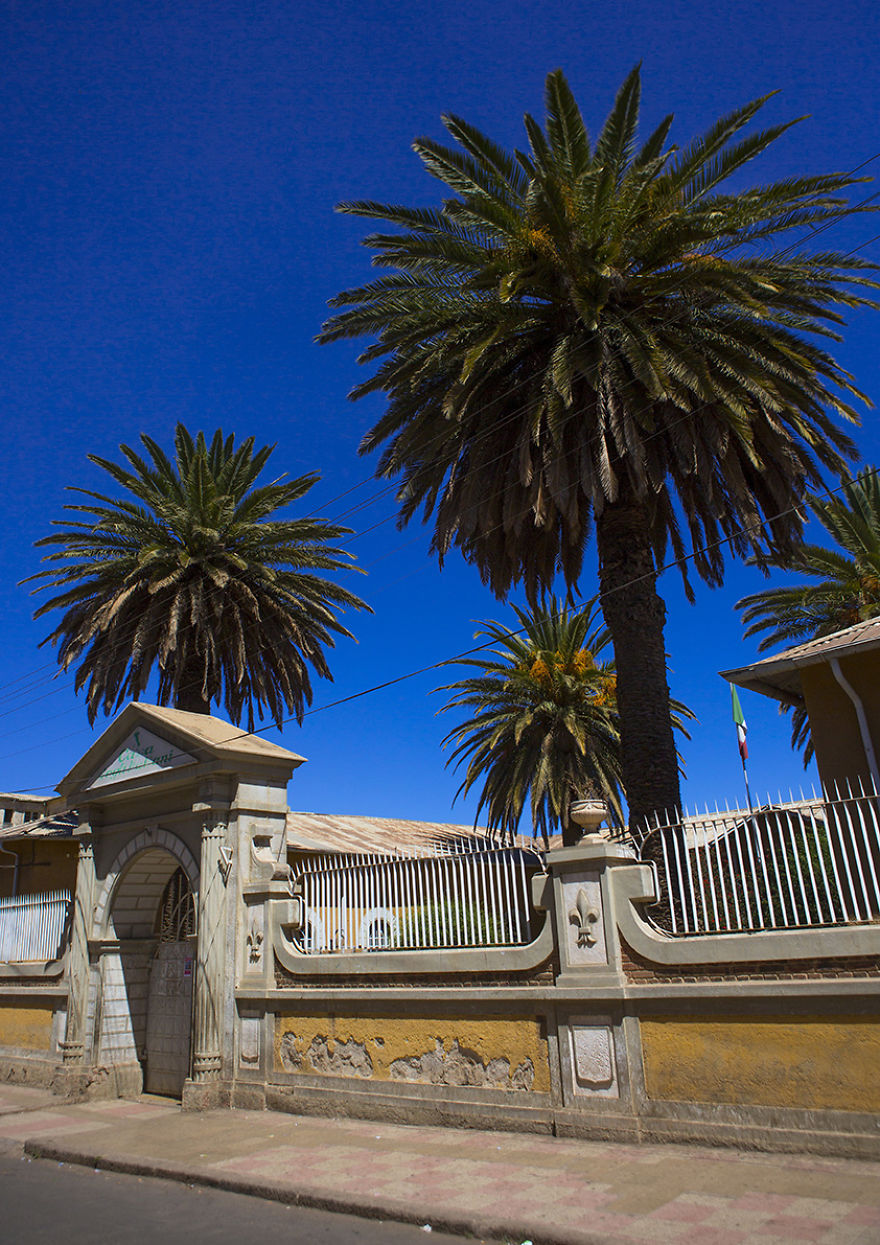Asmara in Eritrea which has been listed by UNESCO as a World Heritage in july 2017, may be compared to Miami, even if it lays 2356m above sea level : it offers a concentration of
incredible Att deco, Neo-Romanesque, Rationalist, Modernist, and Futurist architecture thanks to the Italian
colonizers who left in 1941. Mussolini had the ambition to create the « Second Roman Empire » across Libya, Eritrea
and Somalia. In 1890, Eritrea became the first territory to fall under Italian Rule. Like Hitler, he wanted to express his
power via architecture.
Before the WW2, 50000 Italians were living in Asmara and the town was called Piccolo Roma. Mussolini told the best
architects from Italia to build the most modernist and futurist buildings in Eritrea, that became a land of innovation.
Those beautiful buildings must not hide the fact that the city was ruled by apartheid. Only the Italians could enjoy
the city center and its architecture. Asmara was an utopian city project but with strict segregation. Outside, natives
were living in poor conditions. Nowadays, the numerous bars and restaurants are full of « asmarinos » with black skin,
but it was not the case under Mussolini power.
The old Italian buildings are now occupied by native people, who take a kind a revenge on the way their parents and
grand parents were treated by the colonialists.
In 1941 during WW2, Eritrea was seized by the British. They built nothing, only some old letter Boxes can be seen in
the streets.
Then Ethiopia took power, and Eritrea gained independence only in 1991 after a long war. Asmara was never
bombed by the Ethiopian Migs, and kept all its architectural treasures. But the conflict with Ethiopia put Eritrea in
very bad economic situation, and many buildings have started to fall into disrepair due to the lack of budgets.
Thanks to UNESCO, regeneration programs will soon be launch to restore many of the unique buildings, and the city
may start to become a new tourist destination.
In the same time, thousands of Eritreans leave illegally their country, oppressed by poverty and the lack of freedom,
to try to live a new life in Europe.
Ironically, many die on the shores of Italia…
More info: ericlafforgue.com
General view of the town. All the buildings are authentic, no new buildings have been built for decades in the city center. Outside of the area, under Mussolini power, there was the Villaggio Indegino. Asmara was an utopian city project but with strict apartheid.
The airplane shaped Tagliero FIAT garage built by architect Giuseppe Pettazzi, in 1938, and similar to Franck Lloyd Wright’s art. The building has 98 foot long concrete wings, stretching above the ground on each side of the pillars. For long time it was abandoned, but it may be turned into a bar soon.
The local authority did not believe that this concrete structure could stand up by itself. So they forced the architect to put lots of little columns underneath in order to support it. When the structure was built, Pettazzi was reported to have held a gun to the builder’s head. He survived!
Alfa Romeo appartements built in 1937 for the managers as the brand was established in Eritrea. The war with Ethiopia has put Eritrea in very bad economic situation, and many buildings have started to fall into disrepair due to the lack of budgets.
The Irga building was constructed in 1961 and designed by Carlo Mazzetti
Former apartments build in the 40s, that became the « Bristol Pension » during the british administration.
The Piscina Mingardi now Asmara Swimming Pool was built by Arturo Mezzedimi at the age of 22 in 1944 . The Swimming Pool was his first significant and important design.
The Central Post Office building of Asmara was completed in 1916. It once served as a High Court. In the middle, a huge art deco table .
A beautiful art deco villa in the city center. Many of the best buildings are now rented by international organizations or companies.
The Casa dei Italiani in Asmara was originally the Fascist youth club, Casa dei Ballila. At the front gate the traditional Fascist insignia, the fasces, can still be seen. It used to be a Fascist club. It is now a restaurant for rich expatriates and the small Italian-speaking Eritrean community who like to come to watch football on TV there.
The Church of Our Lady of the Rosary) stands along Liberty Avenue. It was built in 1923 by the architect Scanavini to a classical Italian design. It is thought to be one of the finest Lombard-Romanesque-style churches outside Italy. According to the plaque inside the church, Mussolini himself was a patron of its construction.
Enda Mariam Orthodox Cathedral was built in 1938 and is a curious mix of Italian and Eritrean Architecture. The towers are topped with tukuls (the traditional eritrean hut roof).
Al Khulafa al Rashedin (Followers of the Right Path) is one of Eritrea’s most sacred Islamic shrines that was completed in 1938 by Guido Ferrazza. The complex combines Rationalist, Classical and Islamic styles.
Falletta Art Deco Building on Harnet Avenue. Designed by Giuseppe cane in 1937. Many glasses are missing on the windows and the building is in bad shape, but the place is prestigious and high rank people from the Army and the government are living there.
Former City Sanitation Modernist office turned into a garage on Massawa road. Lot of factories were also built in the city of Dekemare by italians.
The old Italian buildings are now occupied by native people, who take a kind a revenge on the way their parents and grand parents were treated by the colonialists.
Cinema Impero on Liberation Avenue, built in 1938. The Cinema is made up of three massive windows with 45 porthole lamps. The auditorium can welcome 1800 people.
The art deco Cinema Roma was built in 1937 as the Cinema Excelsior. The facade is decorated with marble. It was re-named Cinema Roma during the Italian fascist occupation.
The old Opera House is not working anymore. It was designed by Cavagnari and completed around 1920. The bar is popular and local people like to came to drink a coffee while watching TV in this wonderful place.
Service station designed by Carlo Marchi and Carlo Montalbetti in 1938
Central square and its arcades which welcome shops where people take the buses.
Albergo Italia, Former Keren Hotel was built in 1899 and is the oldest hotel in Asmara. In the same time, thousands of Eritreans leave their country and its architectural teasures, oppressed by poverty and the lack of freedom, to try to live a new life in Europe. Ironically, many die on the shores of Italia…
Thanks to UNESCO, regeneration programs will soon be launch to restore many of the unique buildings, and the city may start to become a new tourist destination.
538views
Share on Facebook
 Dark Mode
Dark Mode 

 No fees, cancel anytime
No fees, cancel anytime 



















































4
2